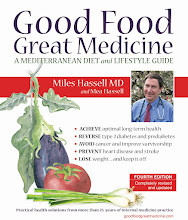Chili (con Beans and con
Carne) Page 235
This can be
simple or complex, fancy or plain, vegetarian or not. You can use whatever beans you like. I cook my own beans (see page 198) or use
canned pinto beans. You can make it hot,
or tame like this version. You also may
prefer a soupier chili than this one. We
generally serve chili over brown rice, but a decadent alternative is to serve
it over Easy, Cheesy Polenta (page
217).
(Serves 4 – 6)
¼ cup extra-virgin olive oil
2 medium-large onions, ¼-inch dice (6 cups)
1–2 bell peppers, diced (1½–3 cups)
Optional: 1–2 jalapenos, seeded, finely diced
1–2 tablespoons freshly crushed garlic
2
tablespoons chili powder
1 tablespoon ground cumin
1 teaspoon oregano
1 fat tablespoon honey
2 teaspoons salt
1 teaspoon freshly ground pepper
1 pound ground or chopped meat (see
note)
-or- chopped leftover cooked meat,
especially leftover Ono Oven Smoked Pig (page
240)
1 can (28 ounces) crushed tomatoes
3 cups cooked beans (15-ounce can is
about 1½-cups drained beans)
Optional:
1 cup chopped cilantro, if available
 |
Onions, bell peppers, and jalapenos sauteing
in extra-virgin olive oil. |
 |
Sauteed vegetables cooking with garlic
and an assortment of spices. |
 |
This chili is hearty and delicious with the addition
of flatiron steak. |
 |
| Here I am quickly browning the meat. |
 |
This is the finished chili after simmering for
30 minutes over very low heat. |
1. Heat
oil in 6-quart heavy pot over medium high heat and sauté onions briskly for
about 8 minutes, then add peppers (and jalapenos, if you have them) and cook
for 5 more minutes, or until onions and peppers are tender. Stir in garlic and seasonings and cook for
another few minutes.
2. Keeping
heat at medium-high, push vegetables to the sides of the pot and add meat. Sauté briskly until browned.
3. Add
tomatoes and drained beans. Bring to a
simmer and cook very gently, uncovered, for about 30 minutes, stirring from
time to time. Avoid letting the chili
boil. Keep in mind that the longer you
cook it, the drier it gets. Taste for
flavor – the chili may need a dose of bottled fire of your choice, depending on
the amount of beans and/or meat you ended up using.
4. Add
cilantro within an hour of serving, to maintain color and flavor, or serve on
the side. (If made in advance, let cool completely, uncovered, before storing in
refrigerator.)
Note:
4 I
like to either serve chili with sides of Pico
de Gallo and Avocado Salsa (both
on page 175) or with side dishes of topping options like grated sharp cheddar
cheese, sliced green onions or diced mild white onions, diced avocado, extra
chopped cilantro, and minced fresh jalapenos.
Chopped
meat versus ground meat
Ground beef or pork (or whatever meat
you like) works fine, but I like to chop my own – the texture is completely
different than ground meat. My choice is
flatiron steak, which is fairly tender and rich, and I use a very sharp chef’s
knife – mine is 11 inches,
which makes easy work of it. I ignore
the tough connective tissue that always seems to run across the underside of
the steak – I chop it finely and it is unnoticeable. The meat is even easier to chop if you put it
in the freezer until it’s semi-frozen – at least 30 minutes. (The flatiron steak I get is sold in handy
vacuum packs, which makes it easy to just slip it in the freezer.) The almost-frozen meat is steadier under the
knife and faster to chop. It’s worth the
extra work, in my opinion.







